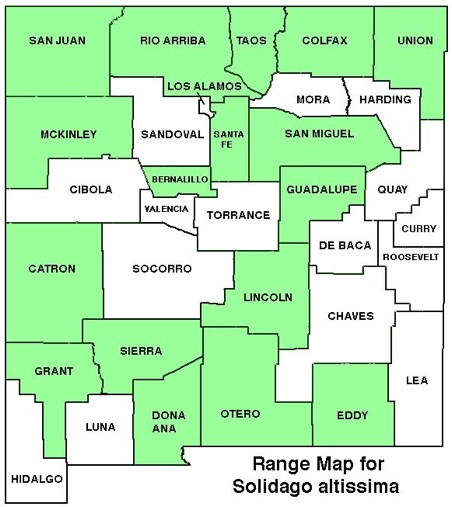WILDFLOWERS OF NEW MEXICO

Short scratchy hairs cover the leaves and stems below the flowers of this erect, 2–6-foot tall plant. In late summer, hundreds of small, yellow flower heads bloom on the branching stems. Note the one-sided floral branches within the cluster, and leaves with 3 prominent veins. This robust plant spreads by rhizomes and can form thick colonies.
FLOWER: August–November. Arrays of flowers form dense plumes that may be spreading, curving, pyramid- or club-shaped. Each floral stem has flowers mostly along one side. The tiny flower head has 8–13 rays to 1/16-inch long (2 mm).
LEAVES: Basal leaves absent; mid-stem leaves alternate. Blades stalkless, hairy, lance-shaped, 1 3/4–4-inches long (4.5–10 cm), 1/4–5/8-inch wide (7–16 mm), with a few shallow teeth toward the tip. Leaf blades have 3 strong nerves and get much smaller in size up the stem. Large insect galls often occur on the upper leaves.
HABITAT: Sunny, moist soils of stream banks, fields, roadsides, open woods; desert scrub, pinyon, ponderosa-oak, Douglas fir forests.
ELEVATION: 3,300–8,750 feet.
RANGE: AZ, CO, NM, TX; widespread in all states east of Rocky Mountains.
SIMILAR SPECIES: With about 17 Solidago species in NM, field identification can be difficult. Another common, tall species, Giant Goldenrod, S. gigantea, scattered in the eastern half of NM, has hairless to sparsely hairy stems and 3-nerved leaves, the largest at mid stem. The widespread Three-nerve Goldenrod, S. velutina, also has a one-sided floral branches and 3-nerved leaves, but has velvety, not short-hairy, stems.
NM COUNTIES: Scattered statewide in moist, low- to mid-elevation habitats: Bernalillo, Catron, Colfax, Dona Ana, Eddy, Grant, Guadalupe, Lincoln, McKinley, Otero, Rio Arriba, San Juan, San Miguel, Santa Fe, Sierra, Taos, Union.









TALL GOLDENROD
SOLIDAGO ALTISSIMA (Solidago canadensis var. scabra)
Aster Family, Asteraceae
Perennial herb









THE CONTENTS OF THIS WEBSITE ARE COPYRIGHTED AND CANNOT BE USED
WITHOUT PERMISSION OF GEORGE OXFORD MILLER



































Flower cluster may be spreading, curving, pyramid- or club-shaped.
Flowers grow on one side of the floral stem within the cluster (arrow).

Mid-stem leaves are crowded on the stem.
Plants spread by rhizomes and can form dense colonies in moist soils.

















EMAIL ME







